What is Cuff?
A cuff is an added piece of fabric present at the lower edge of the sleeve to cover the arms. Cuff s at the wrist that do not have a fastening must be big enough to easily go over the broadest part of the hand. Cuff s on short sleeves should have enough ease allowance for the bicep when it is flexed. The cuff precludes the fraying of the garment and in case of fraying, the garment can be rectified just by replacing the cuff. A simple technique of making cuffs is to fold back the sleeve material at the lower edge. Alternatively, a separate band of material can be sewn onto the sleeve or can be worn separately by means of buttons or studs. A cuff can be made decorative by attaching an ornamental border, lace or other trimming. Sleeves can be finished with a simple hem or a cuff can be used to provide a finished edge to the sleeve; cuffs can be found in a variety of styles. In this article I will explain various types of shirt cuffs with figure.
Different Types of Shirt Cuffs:
Shirt cuffs come in various styles, and they play a significant role in determining the overall look of a shirt. Here are some common types of shirt cuffs:
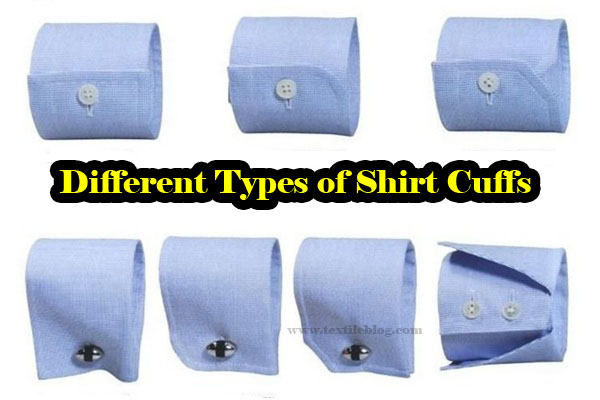
1. Shirt cuffs:
In most cases, the cuffs in shirts are divided down along their length and can be fastened together when the shirt is worn. This facilitates convenient wearing of the shirt and allows the cuff to fit perfectly around the wrist when it is fastened. In garments like sweaters and athletic garments, the cuffs are designed with elastic to enable them to stretch around a hand or foot. Depending on the method of fastening, divided shirt cuffs can be classified into:
A. Button cuffs, also known as barrel cuffs, are provided with buttonholes in one side on the cuff and buttons are sewn correspondingly on the other side. (The fit can be made adjustable by providing more than one button.)
B. Convertible cuffs can be closed with either buttons or with cufflinks.
C. Link cuffs have buttonholes on both sides. They are fastened by means of cufflinks or silk knots. The ‘kissing’ style, where the inner surfaces of both the sides are pressed together, is the widely used fastening method. In rare cases, the outer face touches the inner face, during fastening. Link cuffs come in two kinds:
- Single cuffs, which are the typical linked cuffs, are usually worn along with a white tie or a black tie. Some traditionalists wear the single cuff in combination with lounge suits also.
- French (double cuffs) cuffs can be identified easily by their length. These cuffs are twice as long and need to be folded back while wearing. In earlier days, double cuffs were used to give a more formal look than button cuffs. Previously, French cuffs were required to be worn with a lounge suit or more formal clothing. Today, these cuffs are widely used with many dresses, sometimes even without a tie or jacket. They are highly preferred for semi-formal, black tie events.
2. Barrel shirt cuffs:
A two-button barrel cuff is the most widely recognized style among all off the-rack shirts. Single-button barrel shirt cuffs are recommended for shorter people to create the illusion of longer arms. Likewise, triple-button barrel cuffs are suitable for very tall individuals.
Further, barrel cuffs can come in straight cuts or angled cuts or as rounded barrel cuffs making the shirts more fashionable. Barrel shirt cuffs are worn in many instances like regular work, informal occasions. Sometimes they are even worn for formal occasions though they do not provide a very formal look.
2.1 Single Button Barrel Cuff:
It provides the perception of longer arms and is well suited for shorter persons. Figure 2 shows a shirt with a single button barrel cuff. In actual practices, the single button barrel cuff is considered to be less formal. The major drawback of this cuff style is that the single button often behaves like a pivot and causes the cuff gap to open. Hence, the firmness of the cuff is important in controlling the cuff opening.
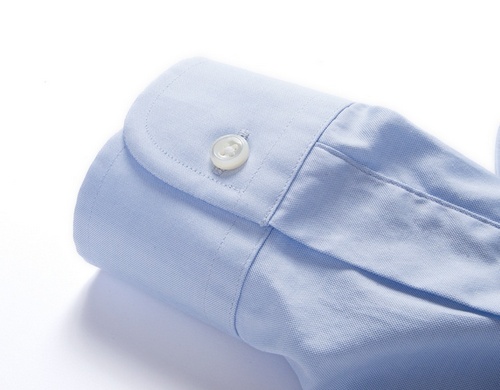
2.2 Double Button Barrel Cuff:
In the double button barrel cuff, the two buttons are aligned vertically along the cuff. Horizontal alignment of the buttons is preferred when the cuff is to be tightened around the wrist. In case of a perfect fit, the horizontal button alignment is not required in the cuffs. Figure 3 illustrates the double button cuff which is a more popular off-the-rack dress shirt style in European nations. These cuffs possess a formal look and are worn with suits. The striking advantage of having two buttons is that the cuff will be retained in place by a single button even if one of the two buttons falls off.
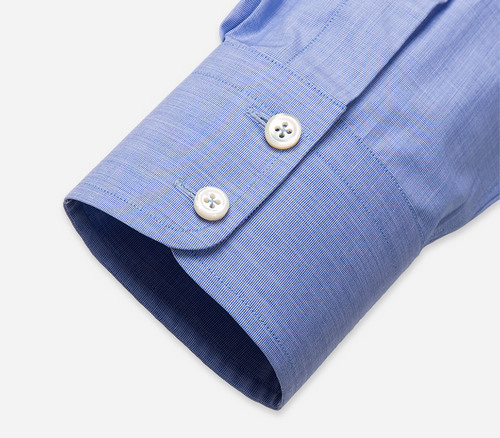
3. French shirt cuffs:
French shirt cuffs provide the best approach to make a shirt more formal. Traditionally, these cuffs were worn with jackets. But now, they are worn with other dresses also. French cuffs can be rendered in numerous styles by varying the type of cufflinks and the cutting styles like straight cut, rounded cut or angled cut.
3.1 Kissing French Cuffs:
The kissing French cuff style is clearly shown in Figure 4. French cuffs, being a part of formal clothing, must be worn in this style. The cuffs are aligned such that their ends kiss each other. The holes should also be in line so that the cufflink can be passed through conveniently.
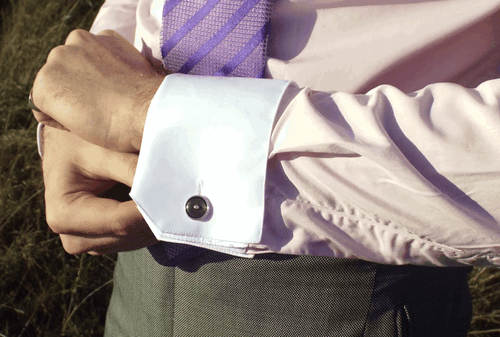
3.2 Undone French Cuffs:
Figure 5 illustrates undone French cuffs. In this particular style, it is not always mandatory to wear cufflinks. Some people fold back the cuff up to the middle and do not make use of a cufflink. It is obvious that this style will not give a pleasant appearance compared to other cuff styles. However, undone French cuffs are preferred while wearing some clothing like a sweater over a shirt. The additional garment over the shirt ensures that the cuff is retained in a particular position.
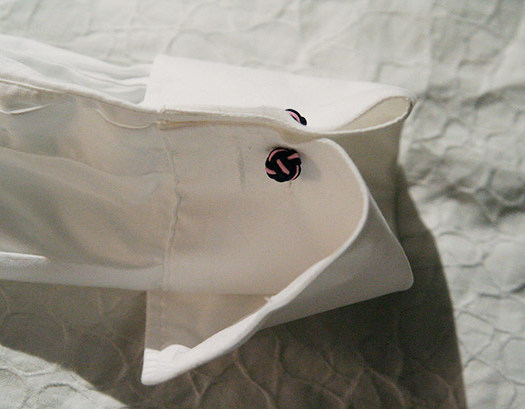
3.3 Barrel French Cuffs:
Barrel French cuffs are an effective alternative to kissing cuffs. In this style, the cuff ends are placed one end below the other such that the holes are inline and the cufflink is passed through them. Figure 6 shows a variant where one end of the cuff end is slid over the other and then passed through a cufflink.
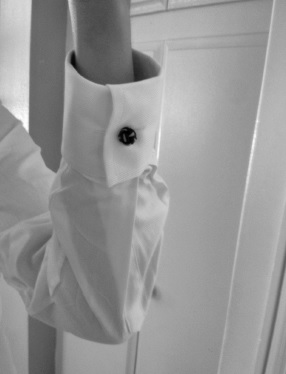
4. Two piece cuff:
This type of cuff is frequently used on men ’s shirts and women ’s blouses. The ends of the cuff s can be curved or straight. Each cuff is made from two pieces.
Suggested dimensions for a cuff on a man ’s shirt:
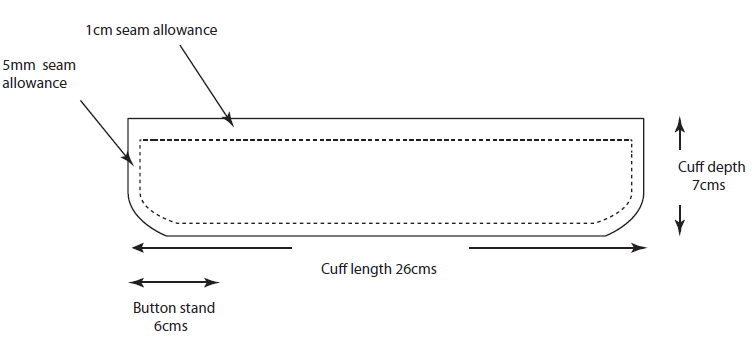
5. One piece cuff:
This cuff is cut from one piece of fabric, see the suggested dimensions in Figure 8 for a cuff on a man’s shirt.
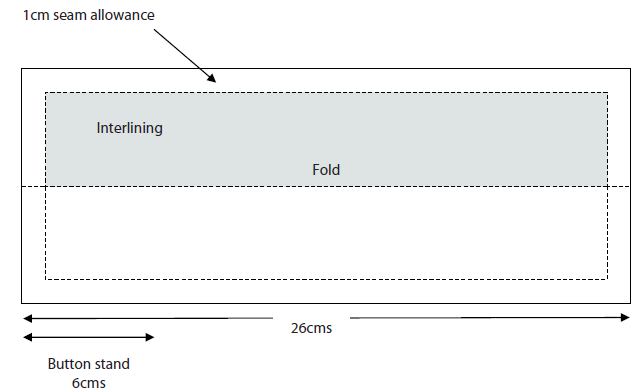
Attaching the Cuff to the Sleeve:
- Join the sleeve underarm seam.
- Turn the sleeve to the correct side, place the cuff inside the sleeve, align the raw edge of the cuff with the bottom of the sleeve and align each end of the cuff with the sleeve opening edges. Fold excess sleeve fullness into one or more pleats. The pleat folds should face towards the opening when the garment is worn. Attach the cuff edge onto the sleeve end using the Lockstitch (301).
- Working on the correct side of the garment, tuck the raw edges of the sleeve into the cuff and close the outside cuff onto the sleeve by stitching 1mm from the edge.
- Finally, insert a buttonhole and attach the button.
Conclusion:
Shirt cuffs play a key role in defining a shirt’s character and adding a touch of individuality to one’s style. When choosing a shirt cuff style, consider the formality of the occasion, personal style preferences, and the type of shirt being worn. Each cuff type can contribute to the overall aesthetic of the shirt and impact the overall look of an outfit.
References:
- Apparel Manufacturing Technology by T. Karthik, P. Ganesan, and D. Gopalakrishnan
- Guide to Basic Garment Assembly for the Fashion Industry by Jayne Smith
- 101 Essential Tips: Sewing: Breaks Down the Subject into 101 Easy-to-Grasp Tips By DK Publishing
You may also like: Garment Manufacturing Process: Step by Step Section Wise
